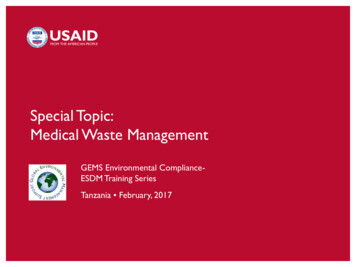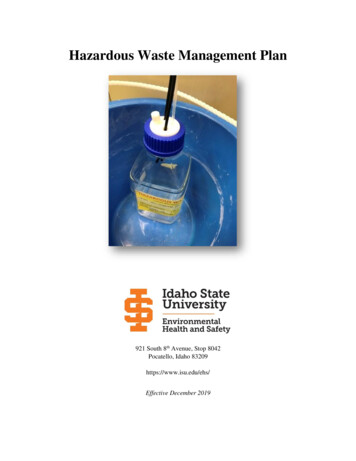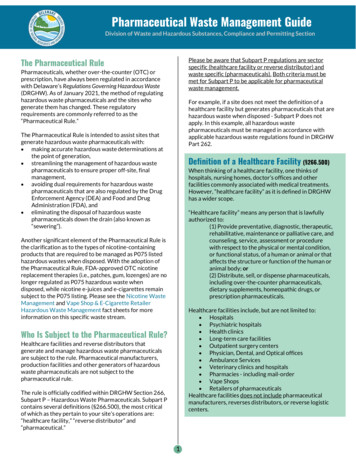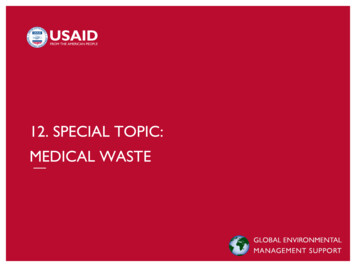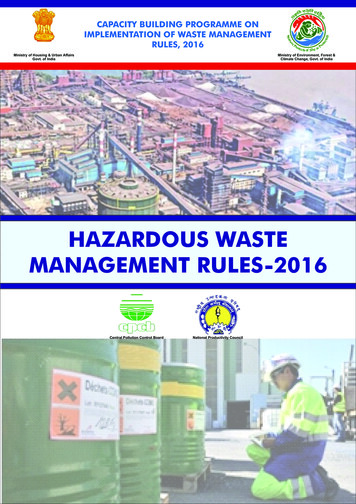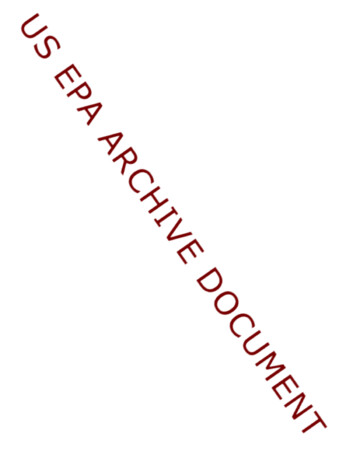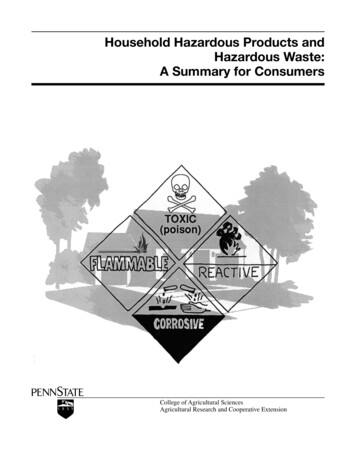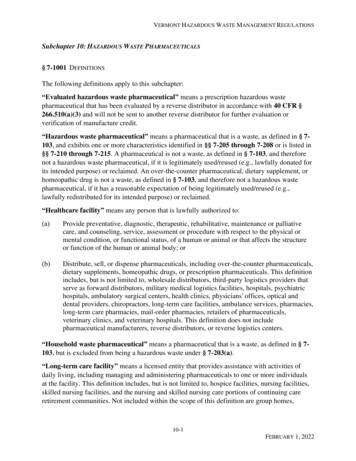
Transcription
VERMONT HAZARDOUS WASTE MANAGEMENT REGULATIONSSubchapter 10: HAZARDOUS WASTE PHARMACEUTICALS§ 7-1001 DEFINITIONSThe following definitions apply to this subchapter:“Evaluated hazardous waste pharmaceutical” means a prescription hazardous wastepharmaceutical that has been evaluated by a reverse distributor in accordance with 40 CFR §266.510(a)(3) and will not be sent to another reverse distributor for further evaluation orverification of manufacture credit.“Hazardous waste pharmaceutical” means a pharmaceutical that is a waste, as defined in § 7103, and exhibits one or more characteristics identified in §§ 7-205 through 7-208 or is listed in§§ 7-210 through 7-215. A pharmaceutical is not a waste, as defined in § 7-103, and thereforenot a hazardous waste pharmaceutical, if it is legitimately used/reused (e.g., lawfully donated forits intended purpose) or reclaimed. An over-the-counter pharmaceutical, dietary supplement, orhomeopathic drug is not a waste, as defined in § 7-103, and therefore not a hazardous wastepharmaceutical, if it has a reasonable expectation of being legitimately used/reused (e.g.,lawfully redistributed for its intended purpose) or reclaimed.“Healthcare facility” means any person that is lawfully authorized to:Provide preventative, diagnostic, therapeutic, rehabilitative, maintenance or palliativecare, and counseling, service, assessment or procedure with respect to the physical ormental condition, or functional status, of a human or animal or that affects the structureor function of the human or animal body; orDistribute, sell, or dispense pharmaceuticals, including over-the-counter pharmaceuticals,dietary supplements, homeopathic drugs, or prescription pharmaceuticals. This definitionincludes, but is not limited to, wholesale distributors, third-party logistics providers thatserve as forward distributors, military medical logistics facilities, hospitals, psychiatrichospitals, ambulatory surgical centers, health clinics, physicians' offices, optical anddental providers, chiropractors, long-term care facilities, ambulance services, pharmacies,long-term care pharmacies, mail-order pharmacies, retailers of pharmaceuticals,veterinary clinics, and veterinary hospitals. This definition does not includepharmaceutical manufacturers, reverse distributors, or reverse logistics centers.“Household waste pharmaceutical” means a pharmaceutical that is a waste, as defined in § 7103, but is excluded from being a hazardous waste under § 7-203(a).“Long-term care facility” means a licensed entity that provides assistance with activities ofdaily living, including managing and administering pharmaceuticals to one or more individualsat the facility. This definition includes, but is not limited to, hospice facilities, nursing facilities,skilled nursing facilities, and the nursing and skilled nursing care portions of continuing careretirement communities. Not included within the scope of this definition are group homes,10-1FEBRUARY 1, 2022
VERMONT HAZARDOUS WASTE MANAGEMENT REGULATIONSindependent living communities, assisted living facilities, and the independent and assisted livingportions of continuing care retirement communities.“Non-creditable hazardous waste pharmaceutical” means a prescription hazardous wastepharmaceutical that does not have a reasonable expectation to be eligible for manufacturer creditor a nonprescription hazardous waste pharmaceutical that does not have a reasonable expectationto be legitimately used/reused or reclaimed. This includes but is not limited to, investigationaldrugs, free samples of pharmaceuticals received by healthcare facilities, residues ofpharmaceuticals remaining in empty containers, contaminated personal protective equipment,floor sweepings, and clean-up material from the spills of pharmaceuticals.“Non-hazardous waste pharmaceutical” means a pharmaceutical that is a waste, as defined in§ 7-103, and is not listed in §§ 7-210 through 7-215, and does not exhibit a characteristicidentified in §§ 7-205 through 7-208.“Non-pharmaceutical hazardous waste” means a waste, as defined in § 7-103, that is listed in§§ 7-210 through 7-215, or exhibits one or more characteristics identified in §§ 7-205 through7-208, but is not a pharmaceutical, as defined in this section.“Pharmaceutical” means any drug or dietary supplement for use by humans or other animals;any electronic nicotine delivery system (e.g., electronic cigarette or vaping pen); or any liquidnicotine (e-liquid) packaged for retail sale for use in electronic nicotine delivery systems (e.g.,pre-filled cartridges or vials). This definition includes, but is not limited to, dietary supplements,as defined by the Federal Food, Drug and Cosmetic Act; prescription drugs, as defined by 21CFR § 203.3(y); over-the-counter drugs; homeopathic drugs; compounded drugs; investigationalnew drugs; pharmaceuticals remaining in non-empty containers; personal protective equipmentcontaminated with pharmaceuticals; and clean-up material from spills of pharmaceuticals. Thisdefinition does not include dental amalgam or sharps.“Potentially creditable hazardous waste pharmaceutical” means a prescription hazardouswaste pharmaceutical that has a reasonable expectation to receive manufacturer credit and is:In original manufacturer packaging (except pharmaceuticals that were subject to a recall);Undispensed; andUnexpired or less than one year past expiration date. The term does not include evaluatedhazardous waste pharmaceuticals or nonprescription pharmaceuticals including, but notlimited to, over-the-counter drugs, homeopathic drugs, and dietary supplements.“Reverse distributor” means any person that receives and accumulates prescriptionpharmaceuticals that are potentially creditable hazardous waste pharmaceuticals for the purposeof facilitating or verifying manufacturer credit. Any person, including forward distributors, thirdparty logistics providers, and pharmaceutical manufacturers, that processes prescriptionpharmaceuticals for the facilitation or verification of manufacturer credit is considered a reversedistributor.10-2FEBRUARY 1, 2022
VERMONT HAZARDOUS WASTE MANAGEMENT REGULATIONS§ 7-1002 APPLICABILITYA healthcare facility that is a very small quantity generator when counting all of itshazardous waste, including both its hazardous waste pharmaceuticals and its nonpharmaceutical hazardous waste, remains subject to § 7-306 and is not subject to thissubchapter, except for §§ 7-1006 and 7-1008 and the optional provisions of § 7-1005.A healthcare facility that is a very small quantity generator when counting all of itshazardous waste, including both its hazardous waste pharmaceuticals and its nonpharmaceutical hazardous waste, has the option of complying with § 7-1002(d) for themanagement of its hazardous waste pharmaceuticals as an alternative to complying with§ 7-306 and the optional provisions of § 7-1005.A healthcare facility or reverse distributor remains subject to all applicable hazardouswaste regulations with respect to the management of its non-pharmaceutical hazardouswaste.With the exception of healthcare facilities identified in subsection (a) of this section, ahealthcare facility is subject to the following in lieu of subchapters 3 through 5:Sections 7-1003 and 7-1006 through 7-1009 of this subchapter with respect to themanagement of:Non-creditable hazardous waste pharmaceuticals, andPotentially creditable hazardous waste pharmaceuticals if they are not destined fora reverse distributor.Sections 7-1003(a), 7-1004, 7-1006 through 7-1008, and 7-1010 of this subchapterwith respect to the management of potentially creditable hazardous wastepharmaceuticals that are prescription pharmaceuticals and are destined for a reversedistributor.A reverse distributor is subject to §§ 7-1006 through 7-1011 of this subchapter in lieuof subchapters 3 through 5 with respect to the management of hazardous wastepharmaceuticals.Hazardous waste pharmaceuticals generated or managed by entities other than healthcarefacilities and reverse distributors (e.g., pharmaceutical manufacturers and reverselogistics centers) are not subject to this subchapter. Other generators are subject toSubchapter 3 for the generation and accumulation of hazardous wastes, includinghazardous waste pharmaceuticals.The following are not subject to Subchapters 1 through 9, except as specified:Pharmaceuticals that are not waste, as defined in § 7-103, because they are10-3FEBRUARY 1, 2022
VERMONT HAZARDOUS WASTE MANAGEMENT REGULATIONSlegitimately used/reused (e.g., lawfully donated for their intended purpose) orreclaimed.Over-the-counter pharmaceuticals, dietary supplements, or homeopathic drugs thatare not wastes, as defined in § 7-103, because they have a reasonable expectation ofbeing legitimately used/reused (e.g., lawfully redistributed for their intended purpose)or reclaimed.Pharmaceuticals being managed in accordance with a recall strategy that has beenapproved by the Food and Drug Administration in accordance with 21 CFR part 7subpart C. This subchapter does apply to the management of the recalled hazardouswaste pharmaceuticals after the Food and Drug Administration approves thedestruction of the recalled items.Pharmaceuticals being managed in accordance with a recall corrective action planthat has been accepted by the Consumer Product Safety Commission in accordancewith 16 CFR part 1115. This subchapter does apply to the management of therecalled hazardous waste pharmaceuticals after the Consumer Product SafetyCommission approves the destruction of the recalled items.Pharmaceuticals stored according to a preservation order, or during an investigationor judicial proceeding until after the preservation order, investigation, or judicialproceeding has concluded and/or a decision is made to discard the pharmaceuticals.Investigational new drugs for which an investigational new drug application is ineffect in accordance with the Food and Drug Administration's regulations in 21 CFRpart 312. This subchapter does apply to the management of the investigational newdrug after the decision is made to discard the investigational new drug or the Foodand Drug Administration approves the destruction of the investigational new drug, ifthe investigational new drug is a hazardous waste.Household waste pharmaceuticals, including those that have been collected by anauthorized collector (as defined by the Drug Enforcement Administration), providedthe authorized collector complies with the conditional exemption in §§ 7-1007(a)(2)and 7-1007(b).§ 7-1003 STANDARDS FOR HEALTHCARE FACILITIES MANAGING NON-CREDITABLE HAZARDOUSWASTE PHARMACEUTICALSNotification and withdrawal from this subchapter for healthcare facilities managinghazardous waste pharmaceuticals:Notification. A healthcare facility must notify the Secretary, using the HazardousWaste Handler Site Identification Form (EPA Form 8700-12), that it is ahealthcare facility operating under this subchapter. A healthcare facility is not10-4FEBRUARY 1, 2022
VERMONT HAZARDOUS WASTE MANAGEMENT REGULATIONSrequired to fill out Box 10.B. (Waste Codes for Federally Regulated HazardousWaste) of the Site Identification Form with respect to its hazardous wastepharmaceuticals. A healthcare facility must submit a separate notification (SiteIdentification Form) for each site or EPA identification number.A healthcare facility that already has an EPA identification number must notify theSecretary, using the Hazardous Waste Handler Site Identification Form (EPAForm 8700-12), that it is a healthcare facility as part of its next Biennial Report, ifit is required to submit one; or if not required to submit a Biennial Report, within60 days of the effective date of this subchapter, or within 60 days of becomingsubject to this subchapter.A healthcare facility that does not have an EPA identification number must obtainone by notifying the Secretary, using the Hazardous Waste Handler SiteIdentification Form (EPA Form 8700-12), that it is a healthcare facility as part ofits next Biennial Report, if it is required to submit one; or if not required to submita Biennial Report, within 60 days of the effective date of this subchapter, or within60 days of becoming subject to this subchapter.A healthcare facility must keep a copy of its notification on file for as long as thehealthcare facility is subject to this subchapter.Withdrawal. A healthcare facility that operated under this subchapter but is no longersubject to this subchapter, because it is a very small quantity generator under § 7-306,and elects to withdraw from this subchapter, must notify the Secretary using theHazardous Waste Handler Site Identification Form (EPA Form 8700-12) that it isno longer operating under this subchapter. A healthcare facility is not required to fillout Box 10.B. (Waste Codes for Federally Regulated Hazardous Waste) of the SiteIdentification Form with respect to its hazardous waste pharmaceuticals. A healthcarefacility must submit a separate notification (Site Identification Form) for each EPAidentification number.A healthcare facility must submit the Hazardous Waste Handler SiteIdentification Form (EPA Form 8700-12) notifying that it is withdrawing fromthis subchapter before it begins operating under § 7-306.A healthcare facility must keep a copy of its withdrawal on file for three yearsfrom the date of signature on the notification of its withdrawal.A healthcare facility must ensure that all personnel that manage non-creditable hazardouswaste pharmaceuticals are thoroughly familiar with proper waste handling andemergency procedures relevant to their responsibilities during normal facility operationsand emergencies.A healthcare facility that generates a waste that is a non-creditable pharmaceutical mustdetermine whether that pharmaceutical is a hazardous waste pharmaceutical (i.e., it10-5FEBRUARY 1, 2022
VERMONT HAZARDOUS WASTE MANAGEMENT REGULATIONSexhibits a characteristic identified in §§ 7-205 through 7-208 or is listed in §§ 7-210through 7-215) in order to determine whether the waste is subject to this subchapter. Ahealthcare facility may choose to manage its non-hazardous waste pharmaceuticals asnon-creditable hazardous waste pharmaceuticals under this subchapter.Standards for containers used to accumulate non-creditable hazardous wastepharmaceuticals at healthcare facilities.A healthcare facility must place non-creditable hazardous waste pharmaceuticals in acontainer that is structurally sound, compatible with its contents, and that lacksevidence of leakage, spillage, or damage that could cause leakage under reasonablyforeseeable conditions.A healthcare facility that manages ignitable or reactive non-creditable hazardouswaste pharmaceuticals, or that mixes or commingles incompatible non-creditablehazardous waste pharmaceuticals must manage the container so that it does not havethe potential to:Generate extreme heat or pressure, fire or explosion, or violent reaction;Produce uncontrolled toxic mists, fumes, dusts, or gases in sufficient quantities tothreaten human health;Produce uncontrolled flammable fumes or gases in sufficient quantities to pose arisk of fire or explosions;Damage the structural integrity of the container of non-creditable hazardous wastepharmaceuticals; orThrough other like means threaten human health or the environment.A healthcare facility must keep containers of non-creditable hazardous wastepharmaceuticals closed and secured in a manner that prevents unauthorized access toits contents.A healthcare facility may accumulate non-creditable hazardous wastepharmaceuticals and non-hazardous non-creditable waste pharmaceuticals in the samecontainer, except that non-creditable hazardous waste pharmaceuticals prohibitedfrom being combusted because of the dilution prohibition of 40 CFR § 268.3(c) mustbe accumulated in separate containers and labeled with all applicable hazardous wastecodes.A healthcare facility must label or clearly mark each container of non-creditablehazardous waste pharmaceuticals with the phrase “Hazardous Waste Pharmaceuticals.”Maximum accumulation time for non-creditable hazardous waste pharmaceuticals at10-6FEBRUARY 1, 2022
VERMONT HAZARDOUS WASTE MANAGEMENT REGULATIONShealthcare facilities.A healthcare facility may accumulate non-creditable hazardous wastepharmaceuticals on site for one year or less without a permit or having interim status.A healthcare facility that accumulates non-creditable hazardous wastepharmaceuticals on-site must demonstrate the length of time that the non-creditablehazardous waste pharmaceuticals have been accumulating, starting from the date itfirst becomes a waste. A healthcare facility may make this demonstration by any ofthe following methods:Marking or labeling the container of non-creditable hazardous wastepharmaceuticals with the date that the non-creditable hazardous wastepharmaceuticals became a waste;Maintaining an inventory system that identifies the date the non-creditablehazardous waste pharmaceuticals being accumulated first became a waste;Placing the non-creditable hazardous waste pharmaceuticals in a specific area andidentifying the earliest date that any of the non-creditable hazardous wastepharmaceuticals in the area became a waste.The non-creditable hazardous waste pharmaceuticals generated by a healthcare facilityare subject to the land disposal restrictions of 40 CFR Part 268. A healthcare facility thatgenerates non-creditable hazardous waste pharmaceuticals must comply with the landdisposal restrictions in accordance with 40 CFR § 268.7(a) requirements, except that it isnot required to identify the hazardous waste codes on the land disposal restrictionsnotification.A healthcare facility that sends a shipment of non-creditable hazardous wastepharmaceuticals to a designated facility with the understanding that the designatedfacility can accept and manage the waste, and later receives that shipment back as arejected load in accordance with the manifest discrepancy provisions of 40 CFR § 264.72or 40 CFR § 265.72 may accumulate the returned non-creditable hazardous wastepharmaceuticals on site for up to an additional 90 days provided the rejected or returnedshipment is managed in accordance with subsections (d) and (e) of this section. Uponreceipt of the returned shipment, the healthcare facility must:Sign either:Item 18c of the original manifest, if the original manifest was used for the returnedshipment; orItem 20 of the new manifest, if a new manifest was used for the returned shipment;Provide the transporter a copy of the manifest;10-7FEBRUARY 1, 2022
VERMONT HAZARDOUS WASTE MANAGEMENT REGULATIONSWithin 30 days of receipt of the rejected shipment, send a copy of the manifest to thedesignated facility that returned the shipment to the healthcare facility; andWithin 90 days of receipt of the rejected shipment, transport or offer for transport thereturned shipment in accordance with the shipping standards of § 7-1009(a).Reporting by healthcare facilities for non-creditable hazardous waste pharmaceuticals.Biennial reporting by healthcare facilities. Healthcare facilities are not subject tobiennial reporting requirements under § 7-708(a), with respect to non-creditablehazardous waste pharmaceuticals managed under this subchapter.Exception reporting by healthcare facilities for a missing copy of the manifest:For shipments from a healthcare facility to a designated facility.If a healthcare facility does not receive a copy of the manifest with the signatureof the owner or operator of the designated facility within 60 days of the date thenon-creditable hazardous waste pharmaceuticals were accepted by the initialtransporter, the healthcare facility must submit:(i)A legible copy of the original manifest, indicating that the healthcare facilityhas not received confirmation of delivery, to the Secretary; and(ii)A handwritten or typed note on the manifest itself, or on an attached sheet ofpaper, stating that the return copy was not received and explaining the effortstaken to locate the non-creditable hazardous waste pharmaceuticals and theresults of those efforts.For shipments rejected by the designated facility and shipped to an alternatefacility.If a healthcare facility does not receive a copy of the manifest for a rejectedshipment of the non-creditable hazardous waste pharmaceuticals that is forwardedby the designated facility to an alternate facility (using appropriate manifestprocedures), with the signature of the owner or operator of the alternate facility,within 60 days of the date the non-creditable hazardous waste was accepted by theinitial transporter forwarding the shipment of non-creditable hazardous wastepharmaceuticals from the designated facility to the alternate facility, thehealthcare facility must submit:(i)A legible copy of the original manifest, indicating that the healthcare facilityhas not received confirmation of delivery, to the Secretary; and(ii)A handwritten or typed note on the manifest itself, or on an attached sheet ofpaper, stating that the return copy was not received and explaining the efforts10-8FEBRUARY 1, 2022
VERMONT HAZARDOUS WASTE MANAGEMENT REGULATIONStaken to locate the non-creditable hazardous waste pharmaceuticals and theresults of those efforts.Additional reports. The Secretary may require healthcare facilities to furnishadditional reports concerning the quantities and disposition of non-creditablehazardous waste pharmaceuticals.Recordkeeping by healthcare facilities for non-creditable hazardous wastepharmaceuticals.A healthcare facility must keep a copy of each manifest signed in accordance with §§7-702(b)(2) through (5) for three years or until it receives a signed copy from thedesignated facility which received the non-creditable hazardous wastepharmaceuticals. This signed copy must be retained as a record for at least three yearsfrom the date the waste was accepted by the initial transporter.A healthcare facility must keep a copy of each exception report for a period of at leastthree years from the date of the report.A healthcare facility must keep records of any test results, waste analyses, or otherdeterminations made to support its hazardous waste determination(s) consistent with§ 7-202(b)(6), for at least three years from the date the waste was last sent to on-siteor off-site treatment, storage or disposal. A healthcare facility that manages all of itsnon-creditable non-hazardous waste pharmaceuticals as non-creditable hazardouswaste pharmaceuticals is not required to keep documentation of hazardous wastedeterminations.The periods of retention referred to in this section are extended automatically duringthe course of any unresolved enforcement action regarding the regulated activity, oras requested by the Secretary.All records must be readily available upon request by an inspector.A healthcare facility must immediately contain all spills of non-creditable hazardouswaste pharmaceuticals and manage the spill clean-up materials as non-creditablehazardous waste pharmaceuticals in accordance with the requirements of this subchapter.A healthcare facility may accept non-creditable hazardous waste pharmaceuticals from anoff-site healthcare facility that is a very small quantity generator under § 7-306, without apermit or without having interim status, provided the receiving healthcare facility:Is under the control of the same person (as defined in § 7-103) as the very smallquantity generator healthcare facility that is sending the non-creditable hazardouswaste pharmaceuticals off-site (“control,” for the purposes of this section, means thepower to direct the policies of the healthcare facility, whether by the ownership ofstock, voting rights, or otherwise, except that contractors who operate healthcare10-9FEBRUARY 1, 2022
VERMONT HAZARDOUS WASTE MANAGEMENT REGULATIONSfacilities on behalf of a different person as defined in § 7-103 of this chapter shall notbe deemed to “control” such healthcare facilities) or has a contractual or otherdocumented business relationship whereby the receiving healthcare facility suppliespharmaceuticals to the very small quantity generator healthcare facility;Is operating under this subchapter for the management of its non-creditable hazardouswaste pharmaceuticals;Manages the non-creditable hazardous waste pharmaceuticals that it receives from offsite in compliance with this subchapter; andKeeps records of the non-creditable hazardous waste pharmaceuticals shipments itreceives from off site for three years from the date that the shipment is received.§ 7-1004 STANDARDS FOR HEALTHCARE FACILITIES MANAGING POTENTIALLY CREDITABLEHAZARDOUS WASTE PHARMACEUTICALSA healthcare facility that generates a waste that is a potentially creditable pharmaceuticalmust determine whether the potentially creditable pharmaceutical is a potentiallycreditable hazardous waste pharmaceutical (i.e., it is listed in §§ 7-210 through 7-215 orexhibits a characteristic identified in §§ 7-205 through 7-208). A healthcare facility maychoose to manage its potentially creditable non-hazardous waste pharmaceuticals aspotentially creditable hazardous waste pharmaceuticals under this subchapter.A healthcare facility may accept potentially creditable hazardous waste pharmaceuticalsfrom an off-site healthcare facility that is a very small quantity generator under § 7-306,without a permit or without having interim status, provided the receiving healthcarefacility:Is under the control of the same person, as defined in § 7-103, as the very smallquantity generator healthcare facility that is sending the potentially creditablehazardous waste pharmaceuticals off site, or has a contractual or other documentedbusiness relationship whereby the receiving healthcare facility suppliespharmaceuticals to the very small quantity generator healthcare facility;Is operating under this subchapter for the management of its potentially creditablehazardous waste pharmaceuticals;Manages the potentially creditable hazardous waste pharmaceuticals that it receivesfrom off site in compliance with this subchapter; andKeeps records of the potentially creditable hazardous waste pharmaceuticalsshipments it receives from off site for three years from the date that the shipment isreceived.Healthcare facilities are prohibited from sending hazardous wastes other than potentially10-10FEBRUARY 1, 2022
VERMONT HAZARDOUS WASTE MANAGEMENT REGULATIONScreditable hazardous waste pharmaceuticals to a reverse distributor.Healthcare facilities are not subject to biennial reporting requirements under § 7-708(a)with respect to potentially creditable hazardous waste pharmaceuticals managed underthis subchapter.Recordkeeping by healthcare facilitiesA healthcare facility that initiates a shipment of potentially creditable hazardouswaste pharmaceuticals to a reverse distributor must keep the following records (paperor electronic) for each shipment of potentially creditable hazardous wastepharmaceuticals for three years from the date of shipment:The confirmation of delivery; andThe shipping papers prepared in accordance with 49 CFR Part 172 subpart C, ifapplicable.The periods of retention referred to in this section are extended automatically duringthe course of any unresolved enforcement action regarding the regulated activity, oras requested by the Secretary.All records must be readily available upon request by an inspector.A healthcare facility must immediately contain all spills of potentially creditablehazardous waste pharmaceuticals and manage the spill clean-up materials as noncreditable hazardous waste pharmaceuticals in accordance with this subchapter.§ 7-1005 HEALTHCARE FACILITIES THAT ARE VERY SMALL QUANTITY GENERATORS FOR BOTHHAZARDOUS WASTE PHARMACEUTICALS AND NON-PHARMACEUTICAL HAZARDOUS WASTEA healthcare facility that is a very small quantity generator for both hazardous wastepharmaceuticals and non-pharmaceutical hazardous waste may send its potentiallycreditable hazardous waste pharmaceuticals to a reverse distributor.A healthcare facility that is a very small quantity generator for both hazardous wastepharmaceuticals and non-pharmaceutical hazardous waste may send its hazardous wastepharmaceuticals off-site to another healthcare facility, provided:The receiving healthcare facility meets the conditions in § 7-1003(l) and § 7-1004(b),as applicable; orThe very small quantity generator healthcare facility meets the conditions in § 7306(c)(2)(d) and the receiving large quantity generator meets the conditions in § 7308(d).10-11FEBRUARY 1, 2022
VERMONT HAZARDOUS WASTE MANAGEMENT REGULATIONSA long-term care facility that is a very small quantity generator for both hazardous wastepharmaceuticals and non-pharmaceutical hazardous waste may dispose of its hazardouswaste pharmaceuticals (excluding contaminated personal protective equipment or cleanup materials) in an on-site collection receptacle of an authorized collector (as defined bythe Drug Enforcement Administration) that is registered with the Drug EnforcementAdministration provided the contents are collected, stored, transported, destroyed anddisposed of in compliance with all applicable Drug Enforcement Administrationregulations for controlled substances.A long-term care facility with 20 beds or fewer is presumed to be a very small quantitygenerator subject to § 7-306 for both hazardous waste pharmaceuticals and nonpharmaceutical hazardous waste and not subject to this subchapter, except for §§ 7-1006and 7-1008 and the other optional provisions of this section. The Secretary has theresponsibility to demonstrate that a long-term care facility with 20 beds or fewergenerates quantities of hazardous waste that are in excess of the very small quantitygenerator limits as defined in § 7-103. A long-term care facility with more than 20 bedsthat operates as a very small quantity generator under § 7-306 must demonstrate that itgenerates quantities of haza
hazardous waste, including both its hazardous waste pharmaceuticals and its non-pharmaceutical hazardous waste, remains subject to § 7-306 and is not subject to this subchapter, except for §§ 7-1006 and 7-1008 and the optional provisions of § 7-1005. A healthcare facility that is a very small quantity generator when counting all of its
